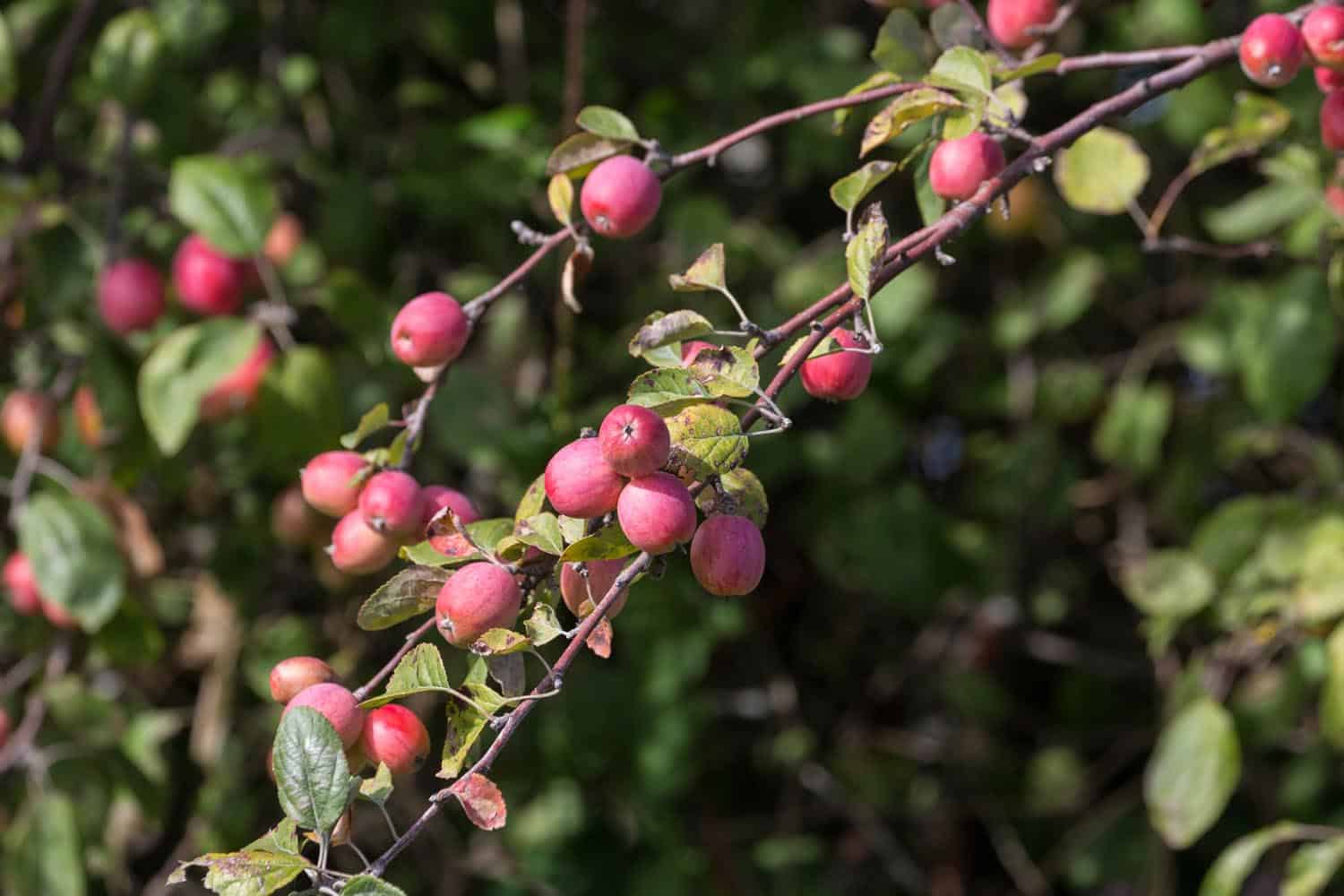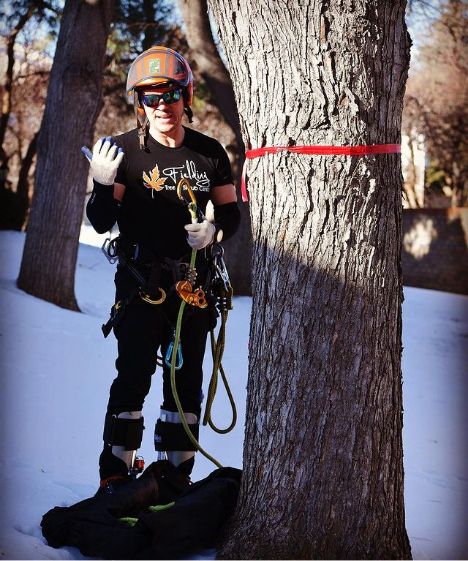Are you ready to “give in to temptation,” as the Denver Post suggests, and add an apple tree or two to your lot? Find out why apple trees in Denver naturally thrive and everything you need to know to keep them healthy, happy and free from apple tree diseases.
Apple Tree Varieties Commonly Found in Denver
You will be delighted to learn that there is a whole host of apple tree varieties that grow well in Denver’s climate. Whether you’re planting for looks or for harvest, check out this guide to help you make your decision.
Already have an apple tree? See these descriptions below to learn more about your tree’s unique history and characteristics.
Cox’s Orange Pippin Apple Tree
A classic English apple tree, the Cox Orange (for short) stands upright and has a habit of spreading. Its blushing yellow-orange apples have a tasty hint of orange and mango. They are often desired for pies, sauces, and ciders. The medium-sized tree prefers loamy, well-drained soil and grows well in Zones 4-8. The Cox’s Orange Apple Tree bears fruit in September but requires another pollinator such as the Golden Delicious for maximum success.
Red Delicious Apple Trees
This tree produces large, red fruit with a sweet flavor, better for allowing it to ripen on the tree. Apples ripen in early October and keep well in storage. You can expect it to yield full crops every other year unless properly thinned, which helps the tree reach bearing age faster. Red Delicious apple trees are roughly 12 – 16’ in both height and spread. They grow best in Zone 4 with a max elevation of 8,500 feet.
Golden Delicious Apple Trees
This apple tree variety is known for being highly productive, yielding large yellow apples that are sweet and juicy with a hint of spice. One benefit of the Golden Delicious is that while it is self-pollinating, it is also one of the most effective pollinators for other apple trees. Its cold-hardy and heat-tolerant disposition make it suitable for Denver’s climate, generally growing well in Zones 4-9. A mature tree grows to about 12 – 15′ tall and 12 – 15′ wide.
McIntosh Apple Trees
If your idea of an apple tree is one that drips with juicy red fruit and gives off that sweet apple aroma, you’re picturing the McIntosh. This cold-hardy tree prefers loamy soil and full sun and can grow at an impressive rate. The vibrantly red and sweet-tart tasting apples ripen in August and are excellent in sauce and ciders. This tree grows well in Zones 4-8 and will measure approximately 12 – 15′ tall by 12 – 15′ wide when fully mature.
Jonathan Apple Trees
The Jonathan apple tree is an American heirloom classic. This tree has parented several varieties throughout the years such as JonaMac, Jonafree, and Jonagold. Jonathan apples are crisp with a sweet-tart taste; a favorite for eating, baking, and cooking. The tree is typically 15 – 20’ in both height and spread. It grows well in Zone 4 at a maximum elevation of 8,500 ft.
Wealthy Apple Trees
Originating from Minnesota, the Wealthy apple tree is cold-hardy and pairs well for pollination with the Golden Delicious apple. Wealthy apples are medium-sized, have tart, juicy, yellow fruits that ripen in September. A mature tree stands about 12 – 15′ tall by 12 – 15′ wide, and grows well in Zones 4-8.
Lodi Apple Trees
Known as an “early bird,” the Lodi apple tree bears fruit and ripens in July! Lodi apples are shockingly bright green, with a tangy, sour taste. Not only is the Lodi apple tree cold-hardy, but it’s also highly resistant to powdery mildew which plagues many other fruit-bearing trees. The apple tree loves full sun and does well in Zones 4-8. At its maturity, the Lodi apple tree will measure 12 – 15′ tall by 12 – 15′ wide.
Haralson Apple Trees
The Haralson tree bears a medium-sized, bright-red winter apple that keeps in storage well. This variety of apple tree is known to be especially hardy, making it a good choice for harsh conditions. They start to bear fruit younger than most apple trees, often in their very first year! Haralson apples are tart and juicy tasting. The trees grow to approximately 12 – 16’ in both height and spread, growing well in Zone 3 at a maximum elevation of 8,500 ft.
Crabapple Trees
There are many varieties of the gorgeous, flowering Crabapple Tree. The “Spring Snow” Crabapple is a fruitless variety, and a common choice in the Denver area for its resistance to disease. The Crabapple’s ability to pollinate makes them a perfect complement to other apple varieties. Mature Crabapple Trees reach approximately 15 to 25 feet.
How To Plant Apple Trees Correctly
Colorado’s rural areas have a reputation for being “orchard country,” and many passionate growers across the state want to keep it that way. If you want to bring some of that sentiment to your Denver property by planting a fruit tree or two, follow Montezuma Orchard Restoration Project’s how-to guide for best success:
- Trees are happiest in the ground, not in a pot, so plant immediately for best success.
- Select a site with good soil drainage and good air flow. Avoid cold sinks.
- Proper spacing is key for optimal development. Space standard apple trees 25-30 feet apart; dwarf 15 feet apart.
- Dig holes 2-3 times wider than the root ball and just deep enough so that the first major lateral root is slightly above the soil line.
- Do not add hot compost, manure, or fertilizer to the planting hole. Backfill with native soil mixed with one third compost material or quality potting soil.
- Protect your tree from deer, rodents, and other mechanical damage with good fencing. Paint the lower south trunk with plain white latex paint diluted with water to protect from sunscald.
- Most apple trees require a pollinator to be planted in close proximity. Planting a single apple tree without a pollinator will result in lack of fruit.
Apple Tree Diseases and Infestations
Apple Tree Pests
Don’t let insects rob you of your delicious apples! Be on the lookout for these pests that prey on apple trees:
Aphids
- Pinhead-sized insects, ranging in color depending on the species. They congregate on stems and under leaves, sucking plant juices.
- Symptoms: Leaf curl, yellowing, and death. Aphids leave behind “honeydew”, a sticky residue that will attract other unwanted insects. Honeydew can, in turn, cause unsightly sooty mold.
- Control: Pesticide
Apple Maggot
- Adults maggots look like a housefly, but smaller. In infancy, larvae are yellowish-white grubs. Apple maggots attack the fruit, laying eggs inside.
- Symptoms: pinpoint-sized sting marks can be seen on the outside of the fruit. Eggs are laid under fruit skin and when larvae hatch they tunnel, making a groove-like pattern.
- Control: Pesticide, Sticky Traps







